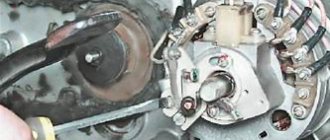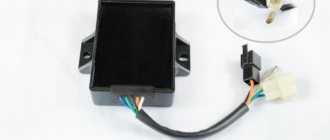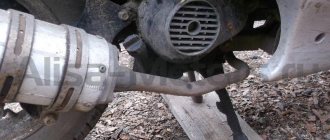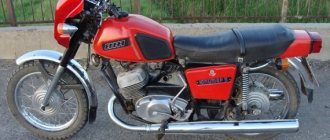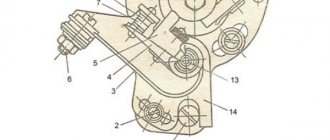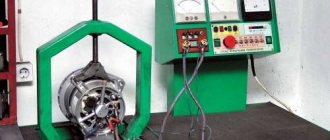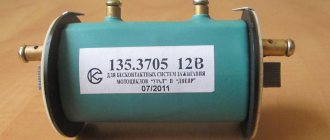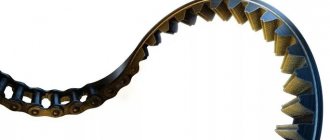When I was little and rode all kinds of mopeds, I didn’t understand how a spark plug could work poorly. And in fact, any spark plugs worked great on motors like D6, you just had to heat them with a blowtorch and pick out the dirt that had accumulated in them. Then I was faced with the fact that spark plugs sometimes malfunctioned on boat engines, although they worked properly on mopeds and chainsaws.
Then I chalked it up to some excessive demands of outboard motors - after all, the water is nearby. Later, when I studied all kinds of electrical engineering subjects, the design of the spark plug seemed so banal to me that it was simply unclear why it would break? In addition, it worked flawlessly on my IZH-PS. In addition, in Soviet times, imported candles were something out of the ordinary. If someone got hold of such a candle, it was a source of pride for the owner. The rest were quite content with domestic ones.
Until recently, I believed that motorcycles produced or at least developed under Soviet rule should be very undemanding in terms of spark plugs. This was confirmed by my “Planet-2” and “Jupiter-3”, as well as by the “IZhi” and “Ural” vehicles of my friends. However, recently there have been more frequent statements that some candles die instantly, and some are completely impossible to drive with. Moreover, candles of very famous and well-deserved people often swear. What's the matter?
Let's start with the spark plug device. Yes, it is terribly primitive and banal - two coaxially located conductors, between which a spark gap is organized. There seems to be nothing to break. Sort of. In reality, everything is much more complicated. The top of the spark plug is “outdoors”, which for a motorcycle means in dust, water and dirt. Therefore, the insulator should be such that there is no overlap on the surface (although this does happen on boxers with their low-lying spark plugs). But this is the simplest thing that spark plugs have to deal with in life. Significantly worse than the lower part, the one located in the cylinder. And there is literally a fiery whirlwind raging there, which seeks to melt the electrodes. At the same time, it also heats the insulator, which at the other end must be cold (otherwise the spark plug wire will melt). But that's not all. What’s worse is that in addition to the gasoline-air mixture, there is also oil in the cylinder. Especially in two-stroke engines. This same oil sticks to the electrodes and insulators of the spark plug, as a result of which it stops working. The method of combating this evil is known - you need to keep the temperature of the spark plug electrodes in the range of 200-500 degrees Celsius. In this case, the oil that gets on the candle burns out safely. And now about this in more detail.
Often, checking a spark plug comes down to unscrewing it from the cylinder and checking for a spark “in the fresh air”. Yes, this is a very accessible test. Although not complete. The fact is that the spark gap increases many times during operation. And all due to the fact that the real compression ratio is 7 (and it never happens less, at least on good modern engines), between the electrodes of the spark plug the gas is under a pressure of 7 atmospheres, which is similar to increasing the spark gap by the same amount. Almost, because there are some tricks. Try to separate the electrodes at a distance of 5 mm, then see the spark! But it may not exist. Remember Ohm's and Kirchhoff's laws? If we imagine the electrical circuit of a spark plug as two parallel resistances (insulator resistance and spark gap resistance), then where will the current pass? Where there is less resistance! And it is smaller where the breakdown occurs. And if the insulator is dirty, then it can be pierced very easily - after all, conductive soot settles on it. And although its length is quite long, over time it can become completely covered with a conductive layer, and then the candle will not spark at all. Or sometimes.
Spark plug characteristics
A motorcycle spark plug has a thermal characteristic, which is designated by a heat rating. The higher this number, the colder the candle.
There are two types of candle temperature:
- A hot spark plug heats up more during engine operation, since it has less heat dissipation from the central electrode and insulator. Engine oil hits the spark plug, heats up and burns quickly, but spark formation is not disrupted. Such spark plugs are suitable for low-boost engines (installed on choppers). When the heat is too strong, the oil may ignite from the spark plug rather than from a spark. Then glow ignition occurs, work stops, engine power is lost, and it may break down.
- A cold spark plug heats up less and prevents glow ignition from occurring, since it has greater heat removal from the central electrode and insulator. But since its temperature is not very high, the engine oil is not burned, which can prevent the formation of a spark. Such spark plugs are suitable for highly boosted engines in which the compression level is high (installed on sports motorcycles).
In what cases is ignition adjustment necessary?
During the operation of the vehicle, the owner faces many problems. The most serious failure is related to the engine. In order to spend significant funds on major repairs, it is necessary to monitor the technical condition of the motorcycle and carry out preventive work, including adjusting the valves and valves (video author - Hana Rulyu).
If you do not monitor the SZ, then the motorcycle engine may not reveal its full potential and will not work at full capacity. This can lead to a reduction in its service life. An ignition adjustment is necessary if the engine is running poorly, the muffler or carburetor is firing. True, before setting up the SZ, you should make sure that the cause of the malfunction is in it.
It happens that the flywheel bolt, which connects the two halves of the crankshaft, comes loose, begins to play and does not work well. Sometimes he even cuts the key.
Setting up the SZ may be necessary after repairing the ignition switch Izh Jupiter 5. The installation and connection itself are carried out according to the diagram.
SZ diagram of the IZh motorcycle
Types of motorcycles and spark plugs
There are many types of motorcycles, each has its own motorcycle spark plug. Let's talk about them in more detail.
Izh-Planeta-5 motorcycles run on A-17B and A-11 spark plugs, but, in my opinion, with A-17B spark plugs the performance of the motorcycle improved, the idle speed became better and there were no difficulties with starting the engine.
Izh-Jupiter-5 motorcycles also run on A-17B and A-11 spark plugs, but when I installed BRISK spark plugs (Czech production), the engine worked better than with Russian spark plugs A-17B and A-11, the power of the motorcycle increased, and the amount of fuel consumed has decreased.
Tula motorcycles run on A-11 and BRISK spark plugs. I checked, A-17 spark plugs are not suitable for this motorcycle.
You can install A-14 and other spark plugs in Dnepr and Ural motorcycles. But only with A-14 candles will movement be more like flying.
For most domestic motorcycles, the best foreign spark plugs are high-quality and reliable BOSH spark plugs.
Platinum and iridium spark plugs are often used, which improve the self-cleaning ability of the spark plugs and extend their life.
For preventative purposes, I recommend changing the spark plugs of your motorcycle every spring or when the season for using other equipment (for example, snowmobiles) begins. In this case, you should not unscrew the spark plug while the motorcycle engine is still hot, as you can damage the threads in the cylinder head.
Let's summarize: when choosing spark plugs, you should take into account the type of motorcycle and the temperature of the plug, then less fuel will be consumed and the motorcycle will go faster.
We're sorry, but the requests coming from your IP address appear to be automated. For this reason, we are forced to temporarily block access to the site.
To continue, please enter the characters from the image in the input field and click "Submit".
Cookies are disabled in your browser
. We will not be able to remember you and correctly identify you in the future. To enable cookies, follow the tips on this page.
Many people believe that all candles are the same, the main thing in them is that there is a spark. But in reality, not everything is so simple... Indeed, without a spark you cannot start the engine. However, it can work quite a bit if you screw the first spark plug that comes to hand into the cylinder head. Java 350-638, which entered the Russian market, were equipped with PAL Super 9 spark plugs from the very beginning. These were high-quality spark plugs, designed for operating engines at high speeds, or, in technical terminology, “cold”, since their heat rating according to GOST corresponds to 26 units. And now the happy owner of a brand new Java, in sacred awe following the requirements of the running-in instructions, trudges along in fourth gear at a speed of 70 km/h. These are favorable conditions for running in the cylinder-piston group. But for someone screwed on, they are simply unbearable. After all, “Java”, being always higher in quality than domestic “classmates”, never overheated during running-in. Therefore, during the break-in mode, although the engine warmed up, it still did not reach the temperature range for which these spark plugs are designed. The result was always the same: due to the lack of self-cleaning effect, the surface of the electrodes and the spark plug insulator is gradually covered with soot, after which an electrical breakdown of the central electrode insulator occurs. It’s rare that a “PAL Super 9” has reached 1 thousand kilometers on a new motorcycle in break-in mode. There are different types of candles - “cold” and “hot”. So, our motorcyclist, without hesitation, screwed an A10 spark plug that happened to come to hand into one of the Java cylinders. And a spark appeared! This happened on the eve of the trip. The engine worked great and there were no signs of problems. This was the case for the first two days, during which the tourist traveled about three hundred kilometers at a calm pace at a speed of about 80 km/h. and on the third day a newly laid highway was found under the wheels. Of course, the speedometer needle went beyond the 100 mark. When we drove about 80 kilometers in this mode, the Java of the unlucky companion fell behind and stopped - the engine jammed. What was supposed to happen happened: the side electrode of the “hot” A10 fell off, it was smeared on the cylinder walls, the rings lay in the grooves and were covered with aluminum. The price of basic technical illiteracy is four hours of wasted time, two broken rings and a damaged piston. It’s good that at least the motorcycle was still running. What, you ask, do you need to know? At least regarding the Kovrov cameras “Voskhod” and “Sova”? Which candles are best to use in them in certain cases? Perhaps, give preference to the products of one candle manufacturer or even purchase imported ones? But which ones? We addressed these questions to Sergei Dmitriev, who heads the Bureau of Testing and Development of ZiD Engines. — For the last 10-15 years, the company has been constantly studying which spark plugs to use. Among the domestic ones, the products of the Engel plant have proven themselves well - A17 and A23 (they come with additional markings). The Czech PAL Super 7, 8 and 9 (now sold under the Brisk brand) deserve high praise. We have been using Bosch W6BC and W7AC spark plugs for about three years now. Quite recently, as an experiment, A14 spark plugs from the Ulyanovsk plant were tested on ZiD. Since the temperature conditions for the operation of the spark plug of a two-stroke “air vent” are very harsh and largely depend on the weather, the amount of water and dirt under the wheels, we conduct a lot of road tests. For motorcycles "Sova" and "ZiD" (175-200 cm'), the warranty period is 12,000 kilometers. During this period, a maximum of two spark plug failures are allowed, and those spark plugs that were tested were within the normal range. According to the test results, of the domestic spark plugs for Kovrov motorcycles, A23 is the most effective. During the warranty period, one failure usually occurs at the fourth to sixth thousand kilometers. The Czech “PAL Super 8” - an analogue in terms of heat rating of our A23 - showed itself better: during the test run it gave practically no failures. For the “Pilot” mokick (class 50 cm), the most suitable heat rating is A17 or any foreign analogue with a short threaded part. It is difficult to say which of them is better - the service life of the engine itself is too short to identify the “winner” in terms of reliability. The situation is approximately the same with the smallest “Kovrovets” - “Ptah”. During the warranty period (2000 kilometers) there were no problems with the spark plugs. “Ptah” is equipped with “Bosch W6BC” at the factory. You can replace them with Ulyanovsk A14s without fear: There are practically no problems with them, the launch is confident - no worse than with Bosch. It is impossible to recommend one type of spark plug for a motorcycle or moped for all occasions. Since the operating temperature of the engine depends on the air temperature, it is advisable to change the spark plugs in different seasons. For example, A23 (they are installed on Owls and ZiDs) are better suited for use in warm (above 20 C) seasons. If the outside temperature is lower, screw in A17. And vice versa, in hot weather or when playing sports, it is better with a “cooler” candle: those for motorcycles are A26, and for “Pilot” - A23. By following these simple rules, you can protect yourself from such troubles as “breakdown” of spark plugs and, even more so, melting of the side electrode. Note: Heat number: a relative value indicating the candle's resistance to heat load. Determined at the stand by comparison with the standard. Self-cleaning effect: burning of carbon deposits formed on the insulator and electrodes of the spark plug. Occurs when the candles are heated to a temperature above 400? C. Electrical breakdown: violation of the dielectric properties of the central electrode insulator. Typically observed when unburned hydrocarbon (carbon deposits) are deposited on the surface of the insulator. More often, this violation occurs at low engine loads. Example: А-У17ДВРМ10 So, in order. 1 familiarity - thread: A - M14x1.25 M - M18x1.5 2nd familiarity - supporting surface: "-" - Flat K - Conical 3rd familiarity - design features: M - Small-sized spark plug for gasoline engine tools U - Reduced hexagon 4th familiarity - Glow number: Hot spark plug >> 8 > 11 > 14 > 17 > 20 > 23 > 26 >> Cold spark plug 5 mark - thread length: no mark - 12.0 mm. D - 190 or 17.5 mm. 6 familiarity - Protrusion of the insulator thermal cone: no sign - Without protrusion B - With protrusion 7 familiarity - Built-in resistor: no sign - Without resistor P - With resistor 8 familiarity - Central electrode: no sign - Standard M - With copper core 9 familiarity - Serial number of development or modernization: no sign - Basic design integer - Modernized design (spark gap)
Why did it happen so?
Perhaps the automatic requests do not belong to you, but to another user accessing the network from the same IP address as you. You need to enter the characters into the form once, after which we will remember you and be able to distinguish you from other users exiting from this IP. In this case, the page with the captcha will not bother you for quite a long time.
You may have add-ons installed in your browser that can make automatic search requests. In this case, we recommend that you disable them.
It is also possible that your computer is infected with a virus program that is using it to collect information. Maybe you should check your system for viruses.
If you have any problems or would like our support team, please use the feedback form.
